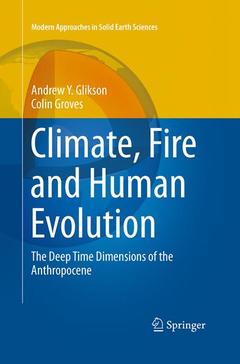Climate, Fire and Human Evolution, 1st ed. 2016 The Deep Time Dimensions of the Anthropocene Modern Approaches in Solid Earth Sciences Series, Vol. 10
Auteurs : Glikson Andrew Y., Groves Colin

Preface
Acknowledgements
Introduction
Part I. Atmosphere-Ocean-Biosphere-Cryosphere Systems and carbon-oxygen cycles
1. Atmosphere dynamics
2. Atmosphere chemistry
The carbon cycle
The oxygen cycle
The sulphur cycle
3. Early Atmosphere-ocean-ice systems
Palaeozoic and Mesozoic atmospheres
Cainozoic atmospheres and ice ages
Evolution of life and mass extinctions
Archaean Life
Acraman Extinction and Acritarchs Radiation
Appearance of multicellular organism
Cambrian and Late Ordovician Mass Extinctions
Late and End-Devonian Mass Extinctions
Late Permian and Permian–Triassic Mass Extinctions
End-Triassic Mass Extinction
Jurassic-Cretaceous Climate Anomalies
K–T (Cretaceous-Tertiary Boundary) Mass Extinction
Paleocene-Eocene Extinction
4. Biological Evolution through the Cainozoic ice ages
5. From primates to humans
6. From genetic evolution to cultural evolution
Part II. Fire The nature of fire
7. The history of fire
8. Fire and human evolution
Fire through the Pleistocene
Neolithic burning and early civilizations
Part III. The Anthropocene
The Anthropocene
Homo sapiens’ war against nature
The Great Carbon Oxidation Event
The Sixth mass extinction of species
An uncharted climate territory
Part IV. Epilogue: Future Blueprints
Appendices:
1. Climate change charts
2. Biologic evolution tree for the Cainozoic
3. Human evolutionary tree
Dr Andrew Glikson is an Earth and Paleo-climate Scientist, Visiting Fellow at the Australian National University, Research School of Earth Science, the School of Archaeology and Anthropology, and the Planetary Science Institute, and a member of the ANU Climate Change Institute.
Explains pre-historic human evolution
Gives insight into the origins of the mastery of fire
Broadens our understanding of climate change
Explores future climate trends
Debates the philosophy of science
Includes supplementary material: sn.pub/extras
Date de parution : 08-2016
Ouvrage de 227 p.
15.5x23.5 cm



